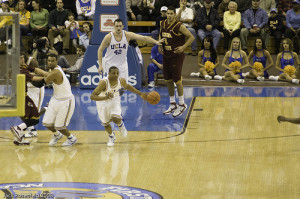Controlling the Tempo of a Game: Speed of the Game
For many coaches one of the major concerns is Controlling the Tempo of a Game. It is often talked about and readily discussed between coaches and their players. You can hear the phrase used in most televised basketball games at some stage when focusing why a team is finding success or if they are failing to meet the standard of play.
The phrase controlling the tempo of the game makes reference to a number of different aspects. Some or all of these aspects can be present when discussing controlling the tempo of a game. For the most part, much of the discussion revolves around aspects like speed of the game, execution of the half-court offense and temperament of the team. These are very broad points however and need to be discussed in further detail to really give any benefit when analysing how a team went in controlling the tempo of a game.
So when examining the aspect speed of the game there is quite a lot of different individual and team based facets to consider. Looking at this point from the perspective of the offense controlling the speed of the game the focus is on the overall team play in transition or over multiple offensive possessions. Is the team playing at the pace they pace want to play at? Characteristics of when the team is not playing at their desired pace might be an increased amount of turn-overs, players not making it to their spots in transition or players generally not running their transition system.

It’s important to note that a team’s speed can be changed to a quicker or slower. Offensive teams can struggle with both faster and slower speeds depending on their natural style of play.
Some other symptoms of poor control over the speed of the game can be seen in the execution of a team’s transition offense when in their attacking third of the court. Team’s that are struggling in controlling the tempo of the game will take poor early shots. This might be seen in players shooting outside their normal shooting range or continuing to try and find scoring opportunities in a situation that has not been successful from multiple times in quick sequence.
For defensive teams the majority of discussion around the pace of the game can be seen in two very distinct scenarios. The first is where the defensive team has the pace of the game increased and this often leads to multiple scoring situations in close succession. A really worrying concern for most coaches immerges when they are then not able to score on their offensive possession to maintain the game’s balance. The second scenario occurs when pace of the game is too slow and the intensity within the defence is eroded. In this situation the offensive team can generally be seen to have control over what opportunities they want to take.
As a coach there are a number of steps you can take to limit the potential for these situations to occur and disrupt your team. When in training utilise scenarios during some of your practice time that set a different rhythm to your offensive transition and shot selection. Simple tools like creating a scenario where “you are down by three points with one shot clock possession remaining”, what will we do? This scenario can just as easily be reversed and be debated from a defensive perspective. Talk about how the players feel, acknowledge the pressure, but then discuss how we as a team can deal with this. Draw your players attention to their roles and how these come together to bring the team success.
Other ways the speed of the game can be changed for the offensive team is when they see a different defensive orientation. When coaching you should try to prepare your offensive players against a wide range of different defences. Try to limit only ever showing your teams to play against a 2-3 Zone defence. Use different zone defences formations to help develop your player’s basketball knowledge and intellect. Have your teams execute their offensive transition against a full court press so when it happens in a game they are more comfortable with the pressure and look for the appropriate options because they know what works.
All coaches will develop their own system and philosophy around coaching and the style of play they like to see as they stay with the sport. Different offensive and defensive systems will have different rhythms. As a coach part of role is preparing your players for a wide range of different tactical situations and being able to deal with these in a constructive and positive way so it will increase your team’s chances of success. Be sure to always focus on the aspects of the game you can control as they will bring you the ultimate success you desire.
Being able to define what “controlling the tempo of a game” really is, leads to a better understanding about the problems associated with poor team performance. This seems like an obvious statement but when talking to coaches there is some confusion around this topic. Different coaches will express what leads to this state of perceived control as a wide variety of aspects of team play and performance. At Functional Basketball Coaching we like to call these Principles of Play and we will discuss these in one of our future posts.





